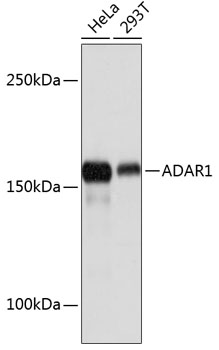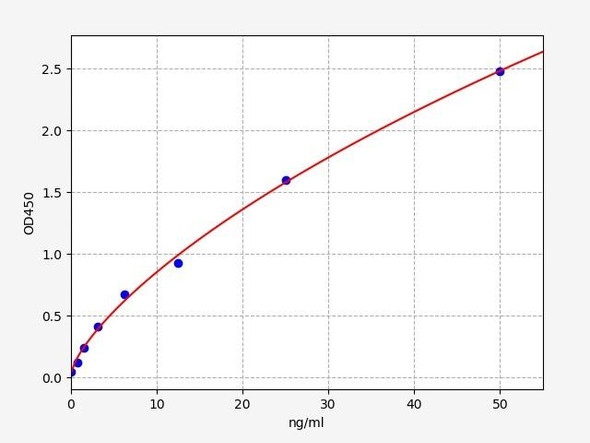Immunology Antibodies 3
Anti-ADAR1 Antibody (CAB11466)
- SKU:
- CAB11466
- Product Type:
- Antibody
- Reactivity:
- Human
- Reactivity:
- Mouse
- Reactivity:
- Rat
- Host Species:
- Rabbit
- Isotype:
- IgG
- Antibody Type:
- Monoclonal Antibody
- Research Area:
- Immunology
Description
| Antibody Name: | Anti-ADAR1 Antibody |
| Antibody SKU: | CAB11466 |
| Antibody Size: | 20uL, 50uL, 100uL |
| Application: | WB IHC |
| Reactivity: | Human, Mouse, Rat |
| Host Species: | Rabbit |
| Immunogen: | A synthesized peptide derived from human ADAR1 |
| Application: | WB IHC |
| Recommended Dilution: | WB 1:500 - 1:2000 IHC 1:50 - 1:200 |
| Reactivity: | Human, Mouse, Rat |
| Positive Samples: | HeLa, 293T |
| Immunogen: | A synthesized peptide derived from human ADAR1 |
| Purification Method: | Affinity purification |
| Storage Buffer: | Store at -20°C. Avoid freeze / thaw cycles. Buffer: PBS with 0.02% sodium azide, 0.05% BSA, 50% glycerol, pH7.3. |
| Isotype: | IgG |
| Sequence: | Email for sequence |
| Gene ID: | 103 |
| Uniprot: | P55265 |
| Cellular Location: | Cytoplasm, Nucleus, Nucleus, nucleolus |
| Calculated MW: | 150kDa |
| Observed MW: | 150KDa |
| Synonyms: | ADAR1, AGS6, DRADA, DSH, DSRAD, G1P1, IFI-4, IFI4, K88DSRBP, P136 |
| Background: | This gene encodes the enzyme responsible for RNA editing by site-specific deamination of adenosines. This enzyme destabilizes double-stranded RNA through conversion of adenosine to inosine. Mutations in this gene have been associated with dyschromatosis symmetrica hereditaria. Alternative splicing results in multiple transcript variants. [provided by RefSeq, Jul 2010] |
| UniProt Protein Function: | ADAR: Converts multiple adenosines to inosines and creates I/U mismatched base pairs in double-helical RNA substrates without apparent sequence specificity. Has been found to modify more frequently adenosines in AU-rich regions, probably due to the relative ease of melting A/U base pairs as compared to G/C pairs. Functions to modify viral RNA genomes and may be responsible for hypermutation of certain negative-stranded viruses. Edits the messenger RNAs for glutamate receptor (GLUR) subunits by site- selective adenosine deamination. Produces low-level editing at the GLUR-B Q/R site, but edits efficiently at the R/G site and HOTSPOT1. Binds to short interfering RNAs (siRNA) without editing them and suppresses siRNA-mediated RNA interference. Binds to ILF3/NF90 and up-regulates ILF3-mediated gene expression. Isoform 1 is induced by interferon alpha. Isoform 5 is constitutively expressed. Homodimer. Isoform 1 interacts with ILF2/NF45 and ILF3/NF90. 5 isoforms of the human protein are produced by alternative promoter. |
| UniProt Protein Details: | Protein type:EC 3.5.4.37; Hydrolase; Nucleolus; RNA processing; RNA-binding Chromosomal Location of Human Ortholog: 1q21.3 Cellular Component: nucleoplasm; membrane; cytoplasm; nucleolus; nucleus Molecular Function:double-stranded RNA adenosine deaminase activity; protein binding; DNA binding; metal ion binding Biological Process: positive regulation of viral genome replication; base conversion or substitution editing; in utero embryonic development; response to virus; cytokine and chemokine mediated signaling pathway; miRNA-mediated gene silencing, miRNA loading onto RISC; somatic diversification of immune receptors via somatic mutation; adenosine to inosine editing; osteoblast differentiation; negative regulation of viral genome replication; pre-microRNA processing; protein import into nucleus; mRNA modification; erythrocyte differentiation; innate immune response; hemopoietic progenitor cell differentiation; gene expression; protein export from nucleus; mRNA processing; defense response to virus; negative regulation of apoptosis Disease: Dyschromatosis Symmetrica Hereditaria; Aicardi-goutieres Syndrome 6 |
| NCBI Summary: | This gene encodes the enzyme responsible for RNA editing by site-specific deamination of adenosines. This enzyme destabilizes double-stranded RNA through conversion of adenosine to inosine. Mutations in this gene have been associated with dyschromatosis symmetrica hereditaria. Alternative splicing results in multiple transcript variants. [provided by RefSeq, Jul 2010] |
| UniProt Code: | P55265 |
| NCBI GenInfo Identifier: | 70167113 |
| NCBI Gene ID: | 103 |
| NCBI Accession: | NP_001020278.1 |
| UniProt Secondary Accession: | P55265,O15223, O43859, O43860, Q9BYM3, Q9BYM4, B1AQQ9 B1AQR0, D3DV76, |
| UniProt Related Accession: | P55265 |
| Molecular Weight: | |
| NCBI Full Name: | double-stranded RNA-specific adenosine deaminase isoform d |
| NCBI Synonym Full Names: | adenosine deaminase, RNA-specific |
| NCBI Official Symbol: | ADAR |
| NCBI Official Synonym Symbols: | DSH; AGS6; G1P1; IFI4; P136; ADAR1; DRADA; DSRAD; IFI-4; K88DSRBP |
| NCBI Protein Information: | double-stranded RNA-specific adenosine deaminase |
| UniProt Protein Name: | Double-stranded RNA-specific adenosine deaminase |
| UniProt Synonym Protein Names: | 136 kDa double-stranded RNA-binding protein; p136; Interferon-inducible protein 4; IFI-4; K88DSRBP |
| Protein Family: | Double-stranded RNA-specific editase |
| UniProt Gene Name: | ADAR |
| UniProt Entry Name: | DSRAD_HUMAN |







